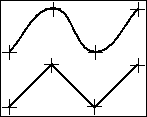How often to sample an anlogue signal?
When monitoring analogue signals, the data acquisition equipment digitises the signal before transferring the reading to the computer. It does this by "sampling" the signal at regular intervals. How do you choose the sampling rate to get an accurate picture of an analogue waveform?
The first thing to decide is how fast the signal is changing. For faster signals this is determined from the maximum frequency component in the signal. For slowly changing signals, such as those from industrial plants, you can use the maximum expected rate of change.
For frequency components the Nyquist theorem demands that the signal be sampled at least twice in each cycle, otherwise the amplitude of this frequency component will distort the signal at lower frequencies. So, sample at least twice as fast as the highest significant component. This rate would not mimic the waveform very closely though.

Angular waveform produced when the signal is sampled at twice its highest frequency. For a more accurate representation sample ten to twenty times this rate.
To get an accurate picture of the waveform you will need a sampling rate of 10 to 20 times the highest frequency.
For slowly changing, essentially DC, signals, then all that is necessary is to consider the minimum time for a significant change in the signal.
Windmill Software
It's easy to set the sampling rate with Windmill Logger, or, for high speed applications, Windmill Streamer. These are supplied with all Microlink hardware. Alternatively Monitor subscribers can ask us for a copy of Windmill for RS232 instruments for free.
